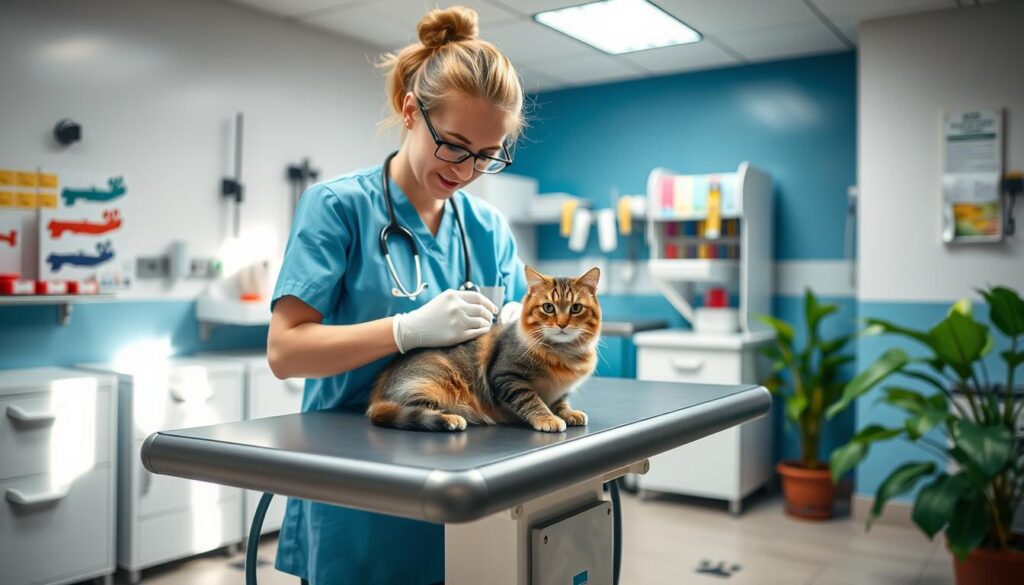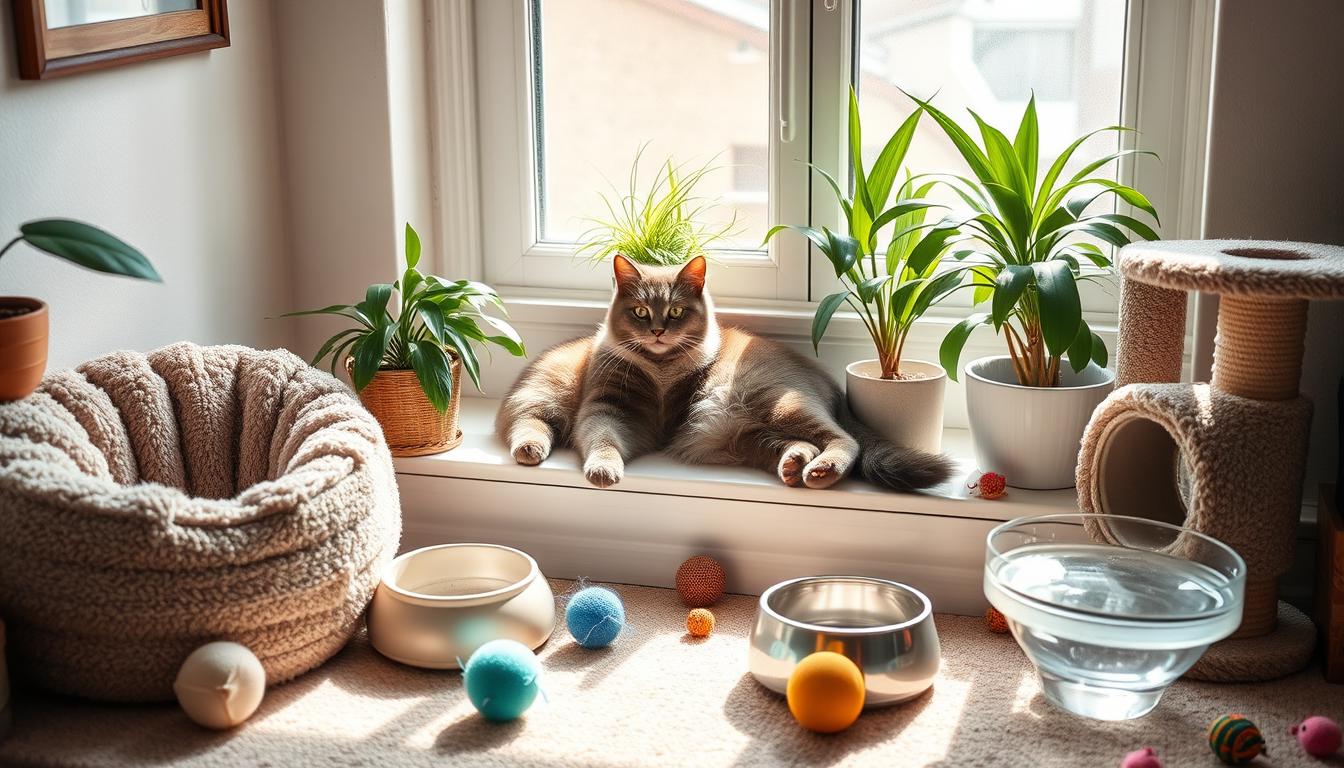As an Amazon Associate I earn from qualifying purchases.
Ever wondered why some cats seem happy while others look stressed? The answer is in proper cat care tips. As a cat owner, you play a big part in your cat’s happiness. Let’s explore how to make your cat happy and content.
Caring for a cat is more than just feeding and housing them. It’s about making a loving space that meets their needs. This includes daily routines and keeping them healthy. These tips are great for both new and experienced cat owners.
Cats are all different, with their own likes and dislikes. It’s important to know what your cat prefers. This way, you can build a strong bond and keep your cat happy and healthy.
Key Takeaways
- Establish a consistent daily routine for your cat
- Provide a balanced diet and fresh water 24/7
- Maintain proper hygiene with regular grooming and litter box cleaning
- Create a stimulating environment with scratching posts and elevated spaces
- Schedule regular veterinary check-ups for preventive care
- Adapt care practices to your cat’s individual needs and life stage
- Balance indoor safety with opportunities for natural stimulation
Understanding Your Cat’s Needs
Cats have unique personalities and specific needs. To make sure your cat is happy and healthy, it’s important to understand their behavior and what they need. Let’s look at the main parts of caring for cats that make their lives better.
The Importance of Routine
Having a regular routine is key for your cat’s well-being. Cats like knowing what to expect. Set times for feeding, play, and grooming. This helps reduce stress and makes your cat behave better. Remember, treats should only be 5-10% of your cat’s diet for a healthy balance.
Recognizing Individual Preferences
Each cat is different, with its own likes and dislikes. Notice what your cat likes in food, toys, and how they like to be interacted with. Some cats love to play hard, while others like gentle petting. Knowing these things helps you care for your cat in a way that keeps them happy and interested.
Adapting Care for Different Life Stages
Cat needs change as they grow from kittens to adults and into their senior years. For example, neutering male cats by five months stops unwanted behaviors. As cats get older, they might need changes in their diet, exercise, and medical care. Regular vet visits help you keep up with your cat’s changing needs at each life stage.
“Cats have emotional systems including lust, fear, panic, rage, and reward-seeking, which are common to all mammalian species.”
Knowing about these emotional systems is crucial for caring for your cat. By meeting their physical and emotional needs, you’ll build a strong bond. This ensures a happy, healthy life for your furry friend.
Proper Nutrition for Feline Health
Cats have special dietary needs. They need nutrients found only in animal products. A diet high in protein, moderate in fat, and low in carbs is best for them.
There are different types of cat food. Dry food has 6-10% water, while canned food has at least 75%. Semi-moist food has about 35% moisture. Mixing these types can help your cat stay hydrated and get various nutrients.

A regular feeding schedule is key for your cat’s health. Adult cats do well with two meals a day, about 12 hours apart. This helps with digestion and prevents overeating. Treats should not make up more than 10-15% of their daily calories to prevent obesity.
| Nutrient | Importance | Sources |
|---|---|---|
| Protein | Essential for growth, maintenance, and repair | Animal-based ingredients in cat food |
| Taurine | Crucial for eye and heart health | Fish, poultry, and fortified cat foods |
| Water | Most important nutrient for cats | Fresh water, wet cat food |
Always talk to your vet to find the best diet for your cat. They can adjust your cat’s nutrition plan based on their age, activity, and health. Proper nutrition is crucial for a happy, healthy cat.
Cat Care Tips for Grooming and Hygiene
Keeping your cat clean and well-groomed is key for their health and happiness. Let’s look at important parts of cat grooming and hygiene. This will help your kitty stay in great shape.
Brushing Techniques for Different Coat Types
Brushing your cat regularly is vital for their hygiene. Cats with long hair need brushing every day. Short-haired cats can get brushed once a week. This keeps their coat clean and reduces hairballs and allergens at home. Pick a brush that fits your cat’s coat for the best effect.
Bathing Your Cat: When and How
Cats are usually self-cleaning, but sometimes they need a bath. Use special cat shampoo and warm water. Make sure to rinse well to avoid skin problems. Cats usually only need baths when they’re very dirty or have a health issue. Always talk to your vet about when and how often to bathe your cat.
Nail Trimming and Paw Care
Trimming your cat’s nails regularly helps prevent scratching issues and keeps them comfy. Trim nails every few weeks, being careful not to cut the quick. If your cat doesn’t like it, start slow and use treats to help. Also, check and clean their paw pads often.
| Grooming Task | Frequency | Benefits |
|---|---|---|
| Brushing (long-haired cats) | Daily | Prevents matting, reduces hairballs |
| Brushing (short-haired cats) | Weekly | Removes loose hair, distributes skin oils |
| Bathing | As needed | Cleans dirty coats, helps with certain skin conditions |
| Nail trimming | Every 2-3 weeks | Prevents scratching damage, maintains paw health |
Grooming time is a chance to bond with your cat and check for health issues. With patience and the right methods, grooming can be fun for both you and your cat.
Creating a Cat-Friendly Environment
Make your home a safe and fun place for your cat. Cats do well in spaces that are safe, comfy, and interesting. Use different cat accessories and toys that match their natural ways.
Cats enjoy looking down from high places. Put cat trees, shelves, or perches near windows. This lets them climb and feel safe. Remember, have one item for each cat, plus one more.
Scratching posts are a must. Put them around your home to save your furniture and let your cat scratch. Choose tall posts so your cat can stretch fully.
Playing is key for your cat’s health. Give them different toys like feather wands or puzzles. This keeps them entertained and meets their hunting needs.
| Cat Resource | Recommended Quantity | Placement Tips |
|---|---|---|
| Litter Boxes | Number of cats + 1 | Quiet, easily accessible areas |
| Water Bowls | Number of cats + 1 | Multiple locations, away from food |
| Scratching Posts | At least one per cat | Near sleeping areas and entry points |
| Resting Spots | Multiple options | Mix of high perches and cozy hideaways |
Make cozy spots for napping with soft beds or blankets in quiet spots. Cats sleep a lot, so they need comfy places. Also, give them places to hide, like cardboard boxes or tunnels, for alone time.
“A well-designed cat-friendly home not only keeps your pet happy and healthy but also strengthens the bond between you and your feline companion.”
Arrange your space with these cat-friendly items to make a happy home. This supports your cat’s needs, making a peaceful home for you and your cat.
The Importance of Regular Veterinary Check-ups
Regular vet visits are key to keeping your cat healthy. These visits catch and prevent serious problems early. Healthy adult cats should see the vet once a year. Kittens and seniors might need to go more often.

Vaccinations and Preventive Care
Cat shots are vital for their health. Your vet will make sure your cat gets the shots it needs, like rabies and feline leukemia. They’ll also talk about how to protect your cat from fleas, ticks, and worms.
Dental Health for Cats
Cats often get dental problems, especially as they get older. Regular vet visits include dental checks to spot and treat problems early. Your vet might suggest professional cleanings or teach you how to brush your cat’s teeth at home.
Addressing Age-Related Health Concerns
Older cats have special health issues. Senior cats need more vet visits to keep an eye on and treat conditions like arthritis or hyperthyroidism. These visits help catch problems early and create treatment plans just for them.
| Cat Age | Recommended Check-up Frequency | Focus Areas |
|---|---|---|
| Kitten (0-1 year) | Monthly | Vaccinations, Growth monitoring, Spay/Neuter |
| Adult (1-7 years) | Annually | Wellness exams, Dental health, Weight management |
| Senior (7+ years) | Bi-annually | Age-related issues, Chronic disease management |
Regular vet care is crucial for your cat’s long, healthy life. These visits give you peace of mind and make sure your cat gets the best care at every stage of life.
Exercise and Mental Stimulation for Cats
Keeping your cat active and engaged is key for their happiness and health. Cat exercise and mental stimulation are vital for a good life for your pet. By adding cat games and interactive play to your daily routine, your kitty will stay fit and sharp.
Cats are most active at dawn and dusk. Schedule your play times during these hours for the best results. Try to have two to three play sessions a day, each lasting 10-15 minutes. Kittens and younger cats might need up to 10 sessions a day.
Varying cat games keeps your cat interested. Change toys every few weeks to keep things fresh. Wand toys mimic hunting, puzzle feeders test problem-solving skills, and laser pointers tap into their hunting.
Don’t overlook vertical space! Cat trees, climbing shelves, and window perches offer both physical and mental stimulation. They let your cat watch the world, satisfy their curiosity, and exercise by jumping and climbing.
“A stimulated cat is a happy cat. Provide your feline friend with plenty of opportunities for play and exploration to keep them content and healthy.”
Mental stimulation is more than just playtime. Consider clicker training or teaching your cat tricks. This not only challenges their mind but also strengthens your bond. With these tips, your cat will stay active, engaged, and happy at home.
Litter Box Maintenance and Training
Learning how to handle cat litter and training your cat is key for their happiness. Your cat’s bathroom habits show how well they are doing. So, it’s vital to do it right.
Choosing the Right Litter and Box
Cats like fine-grained litters that feel like sand, remembering their desert roots. You can choose from clay, clumping, crystal, or plant-based litters. Just remember, cats don’t like deep litter – keep it shallow. For litter boxes, have one box for each cat, plus one extra.
Cleaning and Placement Tips
Clean the litter box at least twice a day. Deep clean it every 1-5 weeks, based on the litter type. Use mild dish soap for cleaning – strong scents might scare your cat off. Put the box in a quiet, easy-to-reach spot. If you have a big house, have a box on each floor.
Troubleshooting Common Litter Box Issues
If your cat stops using the litter box, it might mean there’s a problem. Check if the box meets their needs or if they prefer another spot in your home. Always see a vet to check for health issues. Cats have a much stronger sense of smell than humans, so keep the box clean!
| Litter Type | Pros | Cons |
|---|---|---|
| Clumping | Easy to scoop, controls odor | May track more |
| Non-clumping | Less expensive | Needs more frequent changes |
| Crystal | Excellent odor control | More expensive |
| Plant-based | Eco-friendly | May not clump as well |
Managing Hairballs and Shedding
As a cat owner, you know how tough it can be to deal with cat hairballs and shedding. Regular grooming is crucial for managing these issues. Brushing your cat not only cuts down on hairballs but also strengthens your bond. For long-haired breeds like Persians and Maine Coons, daily brushing is a must.
Did you know older cats and those who groom too much are more likely to get hairballs? While it’s normal to have hairballs sometimes, too many might mean there’s a health issue. A study found a strong link between hairballs and health problems like Inflammatory Bowel Disease. If your cat has hairballs more than once every two months, it’s time to see your vet for a check-up.
To fight hairballs naturally, try adding egg yolks to your cat’s food. The lecithin in egg yolks helps break down fats that stick hair together in the stomach. When shedding a lot, brush your cat more often and change their diet if needed. Remember, good food and water are key for a healthy coat and less shedding. With these tips, you’ll be ready to keep your cat comfy and free from hairballs.
FAQ
Why is routine important for cats?
How often should I feed my adult cat?
How can I keep my cat’s coat healthy?
What kind of environment is ideal for cats?
How often should I take my cat to the veterinarian?
How can I keep my cat physically and mentally stimulated?
What are some tips for proper litter box maintenance?
How can I manage hairballs and excessive shedding?
As an Amazon Associate I earn from qualifying purchases.

